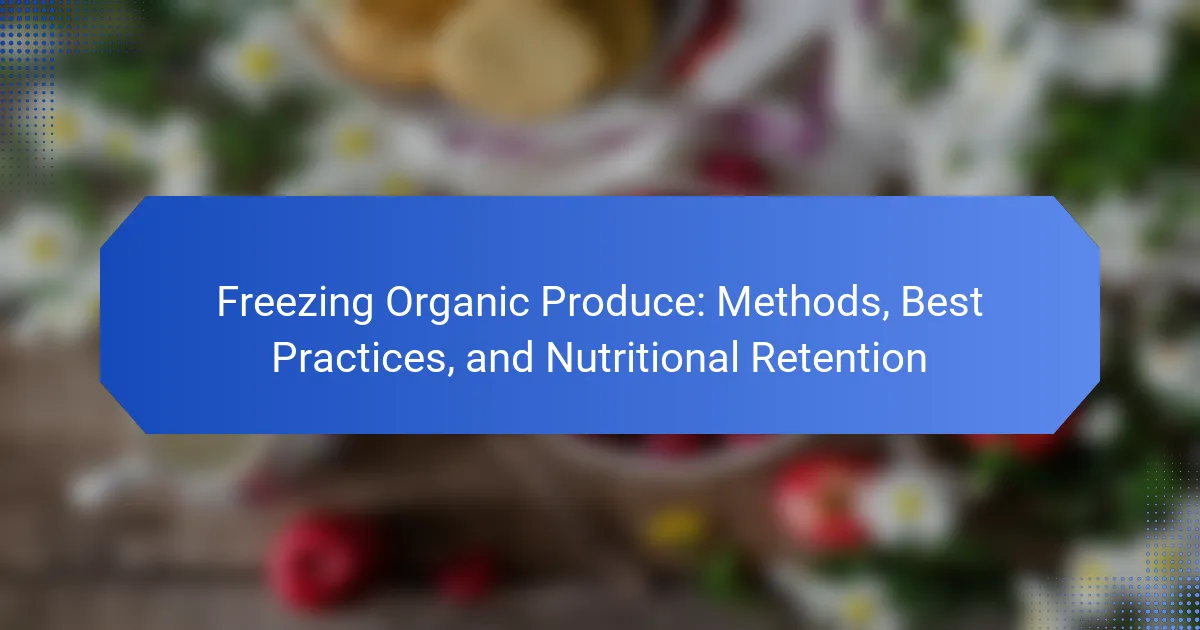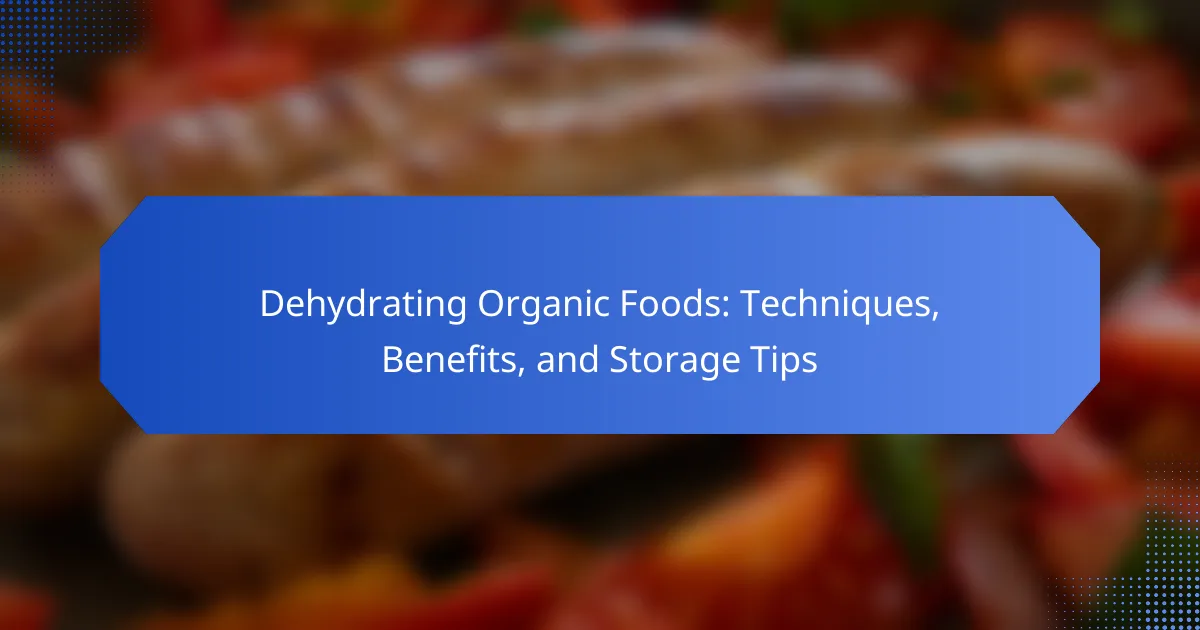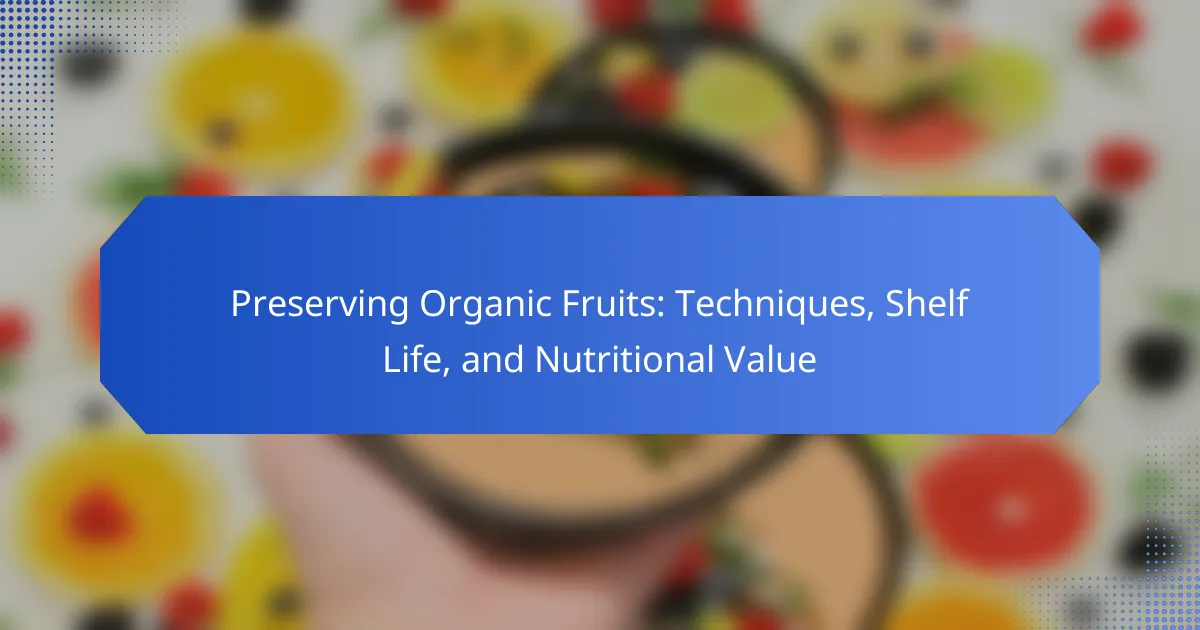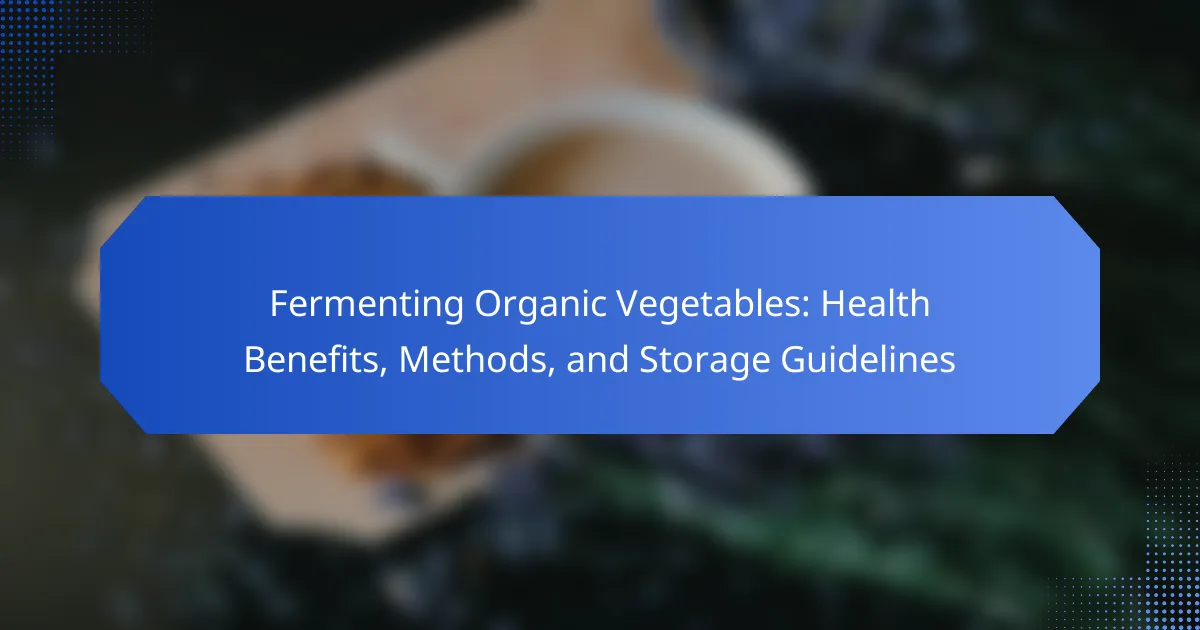Canning organic foods is a preservation technique that involves sealing organic fruits, vegetables, and other food items in containers to extend their shelf life while retaining nutritional value. This process includes heating food to eliminate spoilage-causing bacteria and creating a vacuum seal to prevent contamination. Key aspects of successful canning include using proper equipment, such as pressure canners and water bath canners, sterilizing jars, and ensuring airtight seals. Additionally, selecting fresh, high-quality ingredients and employing minimal processing techniques are crucial for maintaining flavor. This article covers essential canning techniques, safety tips, and methods to enhance flavor retention in organic foods.
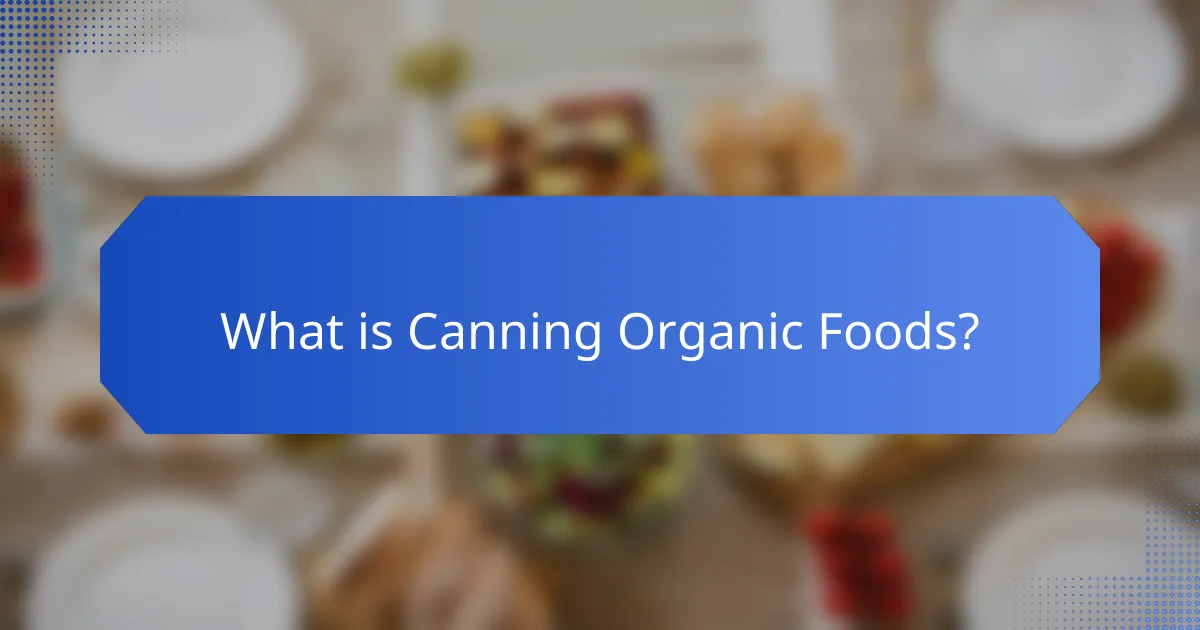
What is Canning Organic Foods?
Canning organic foods is the process of preserving organic fruits, vegetables, and other food items in sealed containers. This method extends the shelf life of organic products while maintaining their nutritional value. Canning involves heating the food to kill bacteria and enzymes that cause spoilage. The sealed containers create a vacuum that prevents new bacteria from entering. This technique allows for seasonal foods to be enjoyed year-round. Studies show that properly canned organic foods retain up to 90% of their nutrients. Canning is a popular method among those seeking to reduce food waste and promote sustainability.
How does the process of canning organic foods work?
Canning organic foods involves preserving them in airtight containers to prevent spoilage. The process begins with selecting high-quality organic produce. The produce is then washed and prepared, which may include cutting or peeling. Next, the food is packed into sterilized jars. The jars are filled with liquid, typically water or brine, leaving headspace for expansion. The jars are sealed with lids and placed in a canner. The canner heats the jars to a specific temperature, killing bacteria and enzymes. This process creates a vacuum seal as the jars cool. Proper canning ensures the food remains safe and retains its flavor for an extended period.
What are the essential steps involved in canning organic foods?
The essential steps involved in canning organic foods include selecting high-quality organic produce, preparing jars and lids, and cooking the food. First, choose fresh, ripe organic fruits or vegetables. Next, wash and cut the produce as needed. Sterilize canning jars and lids by boiling them in water for 10 minutes. Fill the jars with the prepared food, leaving appropriate headspace. Pour hot canning liquid over the food, ensuring it covers the produce completely. Wipe the jar rims to remove any residue. Place the sterilized lids on the jars and screw on the metal bands until fingertip-tight. Process the jars in a water bath or pressure canner for the recommended time based on the food type and altitude. Allow the jars to cool completely before checking seals. Properly sealed jars can be stored in a cool, dark place for up to a year.
How do different canning methods affect the quality of organic foods?
Different canning methods significantly affect the quality of organic foods. Pressure canning typically preserves more nutrients compared to water bath canning. This is due to the higher temperatures achieved in pressure canning, which can kill bacteria and enzymes more effectively. Water bath canning is suitable for high-acid foods but may lead to nutrient loss in low-acid foods. Studies show that improper canning methods can result in texture changes and loss of flavor. For example, a study by the USDA indicates that pressure canning retains more vitamins in vegetables than other methods. The choice of canning method influences the overall quality and safety of the final product.
What are the benefits of canning organic foods?
Canning organic foods preserves their freshness and nutritional content. This method extends shelf life significantly, allowing for long-term storage. Canned organic foods maintain essential vitamins and minerals. For instance, studies show that properly canned vegetables retain 85% of their nutrients. Canning also prevents spoilage caused by bacteria and mold. It provides convenience, enabling quick meal preparation. Furthermore, canning helps in reducing food waste by storing surplus produce. Overall, canning organic foods is an effective way to enjoy seasonal harvests year-round.
How does canning preserve the nutritional value of organic foods?
Canning preserves the nutritional value of organic foods by sealing them in airtight containers. This process prevents exposure to air, which can degrade vitamins and minerals. The high heat used during canning kills bacteria and enzymes that cause spoilage. As a result, essential nutrients are retained for extended periods. Studies show that canned fruits and vegetables maintain comparable levels of nutrients to their fresh counterparts. For example, a study published in the Journal of Food Science found that canned tomatoes retain lycopene, an important antioxidant. Overall, canning effectively locks in the nutritional benefits of organic foods while ensuring their safety for consumption.
What advantages does canning offer for food storage and shelf life?
Canning offers several advantages for food storage and shelf life. It preserves food by sealing it in airtight containers. This process prevents the growth of bacteria, yeasts, and molds. Canned foods can last for years without refrigeration. The canning process retains essential nutrients and flavors. According to the USDA, properly canned foods maintain high quality for up to five years. Canning also allows for seasonal foods to be enjoyed year-round. It minimizes food waste by extending the usability of perishable items. Overall, canning is an effective method for long-term food preservation.
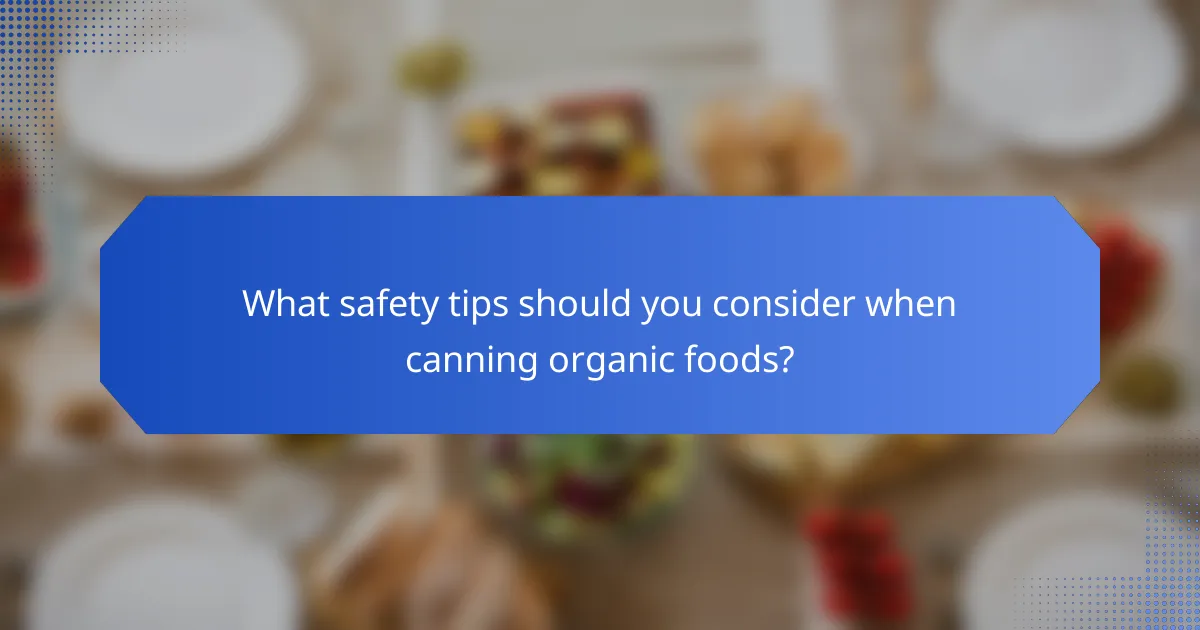
What safety tips should you consider when canning organic foods?
Use proper canning equipment to ensure safety. This includes pressure canners for low-acid foods and water bath canners for high-acid foods. Sterilize jars and lids before use to prevent contamination. Fill jars leaving appropriate headspace to allow for expansion during processing. Process jars for the recommended time based on the food type and altitude. Check seals after cooling to ensure jars are airtight. Store canned foods in a cool, dark place to maintain quality. Discard any jars with broken seals or signs of spoilage. Following these steps minimizes the risk of foodborne illnesses, such as botulism.
How can you ensure safe canning practices?
To ensure safe canning practices, use proper sterilization techniques. Begin by thoroughly cleaning jars and lids with hot, soapy water. Next, sterilize them in boiling water for at least 10 minutes. Use a pressure canner for low-acid foods to achieve the necessary temperature. Maintain an internal temperature of 240°F to kill harmful bacteria. High-acid foods can be processed in a water bath canner for the appropriate time. Follow tested recipes for specific processing times to ensure safety. According to the USDA, following these guidelines significantly reduces the risk of foodborne illnesses.
What are the most common safety risks associated with canning organic foods?
The most common safety risks associated with canning organic foods include botulism, under-processing, and improper sealing. Botulism is a rare but potentially fatal illness caused by toxins from Clostridium botulinum bacteria. This bacteria can thrive in low-acid foods that are not processed correctly. Under-processing occurs when the canning time or temperature is insufficient, allowing harmful microorganisms to survive. Improper sealing can lead to the entry of air, which can spoil the food and create a breeding ground for bacteria. According to the USDA, following recommended canning guidelines is crucial to minimize these risks.
How do you properly sterilize canning jars and equipment?
To properly sterilize canning jars and equipment, start by washing them with hot, soapy water. Rinse thoroughly to remove any soap residue. Next, place the jars and lids in a large pot of boiling water. Ensure they are fully submerged for at least 10 minutes to kill bacteria. Alternatively, you can sterilize jars in a dishwasher on a hot cycle without detergent. For equipment like funnels and tongs, wash them in hot, soapy water and rinse. If desired, you can also boil these items for 10 minutes. This method effectively eliminates contaminants, ensuring safe canning practices.
What guidelines should be followed to avoid contamination?
To avoid contamination during the canning process, follow these guidelines. First, ensure all equipment is properly sterilized. Use boiling water or a dishwasher to sanitize jars, lids, and utensils. Second, work in a clean environment. This minimizes the risk of introducing harmful bacteria. Third, wash hands thoroughly before handling food. Clean hands prevent the transfer of contaminants. Fourth, inspect food for spoilage before canning. Discard any damaged or moldy items. Fifth, process food at the correct temperature and duration. This ensures harmful microorganisms are destroyed. Lastly, seal jars properly to create a vacuum seal. A proper seal prevents recontamination. Following these guidelines significantly reduces the risk of foodborne illness.
What are the signs of spoilage in canned organic foods?
Signs of spoilage in canned organic foods include bulging lids, leaks, or rust on the can. Additionally, a foul odor upon opening indicates spoilage. Discoloration or unusual texture of the food may also be present. If the food has an off-taste, it is likely spoiled. These signs suggest that harmful bacteria may have developed, making the food unsafe to consume. Proper storage and inspection can help prevent these issues.
How can you prevent botulism and other foodborne illnesses?
To prevent botulism and other foodborne illnesses, follow strict canning guidelines. Use proper canning techniques, including pressure canning for low-acid foods. Ensure jars and lids are sterilized before use. Maintain a safe processing time and temperature as recommended by food safety guidelines. Always check for signs of spoilage before consuming canned goods. Store canned foods in a cool, dark place to inhibit bacterial growth. The Centers for Disease Control and Prevention (CDC) states that proper canning methods significantly reduce the risk of botulism.
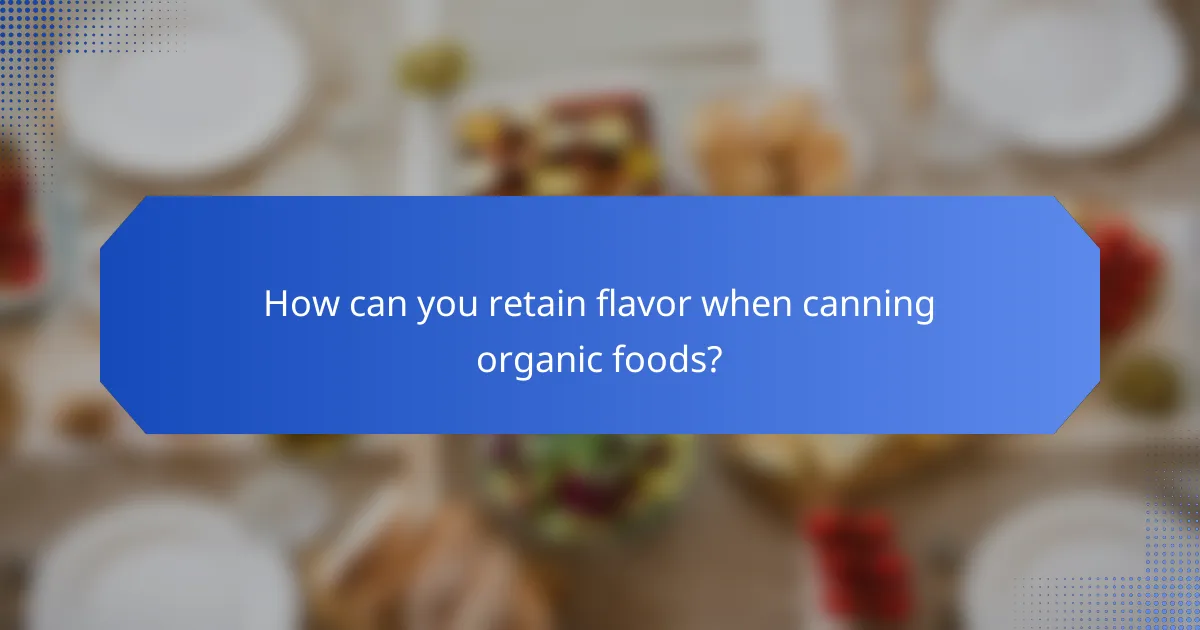
How can you retain flavor when canning organic foods?
To retain flavor when canning organic foods, use fresh, high-quality ingredients. Select produce at peak ripeness to ensure optimal taste. Pre-cook or blanch vegetables briefly to preserve color and flavor. Use minimal processing to avoid flavor loss. Choose appropriate canning methods, such as water bath or pressure canning, based on the food type. Seal jars tightly to prevent air exposure, which can lead to flavor degradation. Store canned goods in a cool, dark place to maintain their flavor over time. Research shows that proper canning techniques can significantly enhance flavor retention in organic foods.
What techniques enhance flavor retention during the canning process?
To enhance flavor retention during the canning process, several techniques are effective. First, using fresh, high-quality ingredients is crucial. Fresh produce retains more natural flavors and nutrients. Second, blanching vegetables before canning helps preserve color, texture, and taste. This process deactivates enzymes that can lead to flavor loss. Third, using the right amount of acidity is essential. Acidity levels affect the preservation of flavors and prevent spoilage. Fourth, sealing jars properly ensures an airtight environment, which minimizes flavor degradation. Additionally, processing jars at the correct temperature and duration is vital. Overcooking can lead to loss of flavor compounds. Lastly, storing canned goods in a cool, dark place helps maintain their flavor over time. These techniques collectively contribute to better flavor retention in canned foods.
How does the choice of ingredients impact flavor preservation?
The choice of ingredients significantly impacts flavor preservation in canned foods. Fresh, high-quality ingredients retain their natural flavors better than older or lower-quality options. Ingredients with high acidity, such as tomatoes and citrus, help inhibit microbial growth, enhancing flavor longevity. Herbs and spices can also contribute to flavor complexity and preservation. Additionally, the absence of preservatives in organic ingredients may lead to quicker flavor degradation. Studies show that the freshness of produce at the time of canning correlates with the final flavor profile. Using proper canning techniques along with quality ingredients further ensures optimal flavor retention.
What role does acidity play in flavor retention of canned organic foods?
Acidity plays a crucial role in flavor retention of canned organic foods. High acidity levels help preserve the natural flavors during the canning process. Acidic environments inhibit the growth of spoilage microorganisms. This leads to longer shelf life and better flavor maintenance. Additionally, acidity can enhance the overall taste profile of the food. Foods with a pH below 4.6 are generally considered safe for canning. This is supported by guidelines from the USDA on safe canning practices. Thus, maintaining appropriate acidity is essential for both safety and flavor in canned organic foods.
What are some common mistakes to avoid in flavor retention?
Common mistakes to avoid in flavor retention include improper sealing of jars. Failing to create a vacuum seal allows air to enter, degrading flavor. Another mistake is using low-quality ingredients. Fresh, high-quality produce retains flavor better during canning. Overcooking the food before canning leads to loss of essential oils and flavors. Additionally, not following recommended processing times can result in undercooked food, affecting taste. Lastly, neglecting to store canned goods in a cool, dark place can cause flavors to deteriorate over time.
How can overcooking affect the taste of canned organic foods?
Overcooking canned organic foods can lead to a loss of flavor and texture. The heat can break down delicate compounds that contribute to taste. As a result, the food may taste bland or overly mushy. Nutrients can also degrade with prolonged cooking. This degradation affects both taste and nutritional value. Studies show that overcooking can diminish the sensory qualities of food. For instance, overcooked vegetables often lose their vibrant flavors and appealing textures. In summary, overcooking negatively impacts the overall quality of canned organic foods.
What tips can help maintain the original flavor of organic foods during canning?
Use fresh, high-quality organic produce for canning. Freshness directly impacts flavor retention. Avoid overcooking to preserve the natural taste of the food. Process jars quickly after filling to minimize exposure to air. Use appropriate canning techniques, such as water bath or pressure canning, to maintain flavor. Ensure jars are sealed properly to prevent spoilage and flavor loss. Store canned goods in a cool, dark place to enhance longevity and flavor preservation. These practices are supported by the USDA guidelines on safe canning methods.
What best practices should be followed for successful canning?
Use sterilized jars and lids for canning. This prevents contamination and ensures food safety. Fill jars with food while leaving appropriate headspace, typically one inch. This allows for food expansion during processing. Process jars in a boiling water bath or pressure canner based on the food type. Use a pressure canner for low-acid foods to prevent botulism. Check seals after cooling to ensure jars are airtight. Store sealed jars in a cool, dark place. Follow USDA guidelines for specific processing times and methods for different foods.
How can you effectively plan your canning sessions for optimal results?
To effectively plan your canning sessions for optimal results, start by organizing your workspace and gathering necessary supplies. Ensure you have jars, lids, and a reliable canner ready. Next, select high-quality, fresh organic produce for canning. This will enhance flavor and preservation quality. Create a canning schedule based on the seasonality of your produce. For example, can tomatoes in late summer when they are at their peak ripeness. Prepare recipes in advance and pre-measure ingredients for efficiency during the session. Lastly, maintain a clean environment to prevent contamination and ensure safety. Following these steps will lead to successful canning outcomes.
What resources are available for learning more about canning organic foods?
Books on canning organic foods include “The Complete Book of Home Canning” by the USDA. This book provides comprehensive guidelines on canning techniques and safety. Online resources such as the National Center for Home Food Preservation offer valuable information. Their website features instructional videos and safety tips. Local extension services often provide workshops on canning. These workshops can enhance practical skills and knowledge. Additionally, community classes are available in many areas. These classes often focus on organic food preservation methods.
Canning organic foods is the process of preserving organic produce in sealed containers to extend their shelf life while maintaining nutritional value. This article covers essential techniques for canning, including the steps involved, different canning methods, and their impact on food quality. It emphasizes the benefits of canning for food storage and sustainability, as well as safety tips to prevent foodborne illnesses. Additionally, the article discusses strategies for retaining flavor during the canning process and common mistakes to avoid, ensuring optimal results in preserving organic foods.
